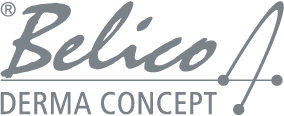Questionable ingredients
Check your cosmetics preparations!
Many cosmetics manufacturers place their emphasis on quick effect. For example, silicones are used to fill wrinkles. From the customer's point of view this may be a quickly visible success, but in the long term, the skin does not get any air to breathe and its natural regeneration is impaired. Skin damage can result from continuous application. Mineral oils and waxes derived from petroleum have the same properties. They smooth the surface of the skin but can also block pores, promoting impurities.
Belico preparations do not contain such questionable ingredients. A few of these substances follow here: taking a bit of a closer look is definitely beneficial.
Mineral oil and mineral waxes
These are synthetic oils or waxes derived from petroleum which, at higher concentrations, can seal the skin and promote the development of pimples. Moreover, petroleum components are also suspected to have carcinogenic properties.
Potential INCI names: Cera Microcristallina, Ceresine, Isohexadecane, Mineral Oil, Ozokerite, Paraffin (Oil), Paraffinum Liquidum, Petrolatum, Vaseline …
Silicone oils
Silicone components can impregnate and develop an occlusive effect (plastic-bag effect). They are used to improve the skin feeling, some act as emulsifier, consistency regulator or solvent.
Potential INCI names: Cyclohexasiloxanes, Cyclopentasiloxanes, Dimethicones, any INCI names including methicone or siloxane.
Parabens
Beyond the desired preservative power of the product, parabens are intended to continue their effect in the human body. Residues of parabens have been found in cancer tumours, which is why they are suspected of promoting cancer. Parabens allegedly have a hormone-like effect on the body and a high risk of allergy as well. According to latest studies, a clearly altered hormone level can already be found in the human body after three days of using paraben-containing cosmetic products.
Possible INCI names: Butylparaben, Ethylparaben, Isobutylparaben, Methylparaben, Propylparaben …
Perfumes
Perfumes are very complex fragrance mixtures with up to hundreds of fragrances. They are among the most common allergy triggers. For purposes of tolerability, perfumes should be excluded from care preparations.
Possible INCI names: aroma, fragrance, perfume.
Comedogenic substances
Other than the mineral oils already mentioned, there are a number of substances suspected to promote the development of pimples.
Possible INCI names: Eucerin, Isopropyl myristate, Isopropyl Palmitate, Isopropyl Stearate, Lanolin …
Substances consisting of PEG and PPG
They act as solubilizing agents, emulsifiers and tensides and cause a more or less severe washout of systemic lipides from the skin. In other words, they impair the function of the skin barrier and can have an irritating effect. They can also promote acne aestivalis with sensitive people.
INCI names including word elements like: Ceteareth, Ceteth, Ceteoleth, Laureth, Oleth, PPG, PEG, Polysorbate, Pareth, Steareth …



